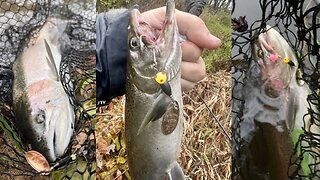Float Fishing For Coho + Bonus Fish / Skein & Beads / The Tail End Of The 2022 Michigan Salmon Run
It's the tail end of the 2022 Michigan Salmon Run and I am taking advantage of my last chance to get some Coho with a chance of steelhead or king salmon being mixed in. Salmon fishing slowed to a hault after some warm weather and most fish left in the rivers now are transitioned to gravel or dead. a sew more salmon will trickle in before winter but for the most part the 2022 Great Lakes Salmon Run is over. Across the state low water is making steelhead fishing poor for the most part so I am in a rut at the moment but expect to find a few salmon or steelhead that will take a bait any day now lol.
Thanks for watching and stay tuned for more Michigan Fishing Videos!
Michigan salmon fishing attracts people from all around the country who wish to chase Great Lakes Salmon. I drive all over the state early in the season every year to fish for king salmon and coho salmon but fishing for coho salmon is my favorite of the 2. In this salmon fishing video I catch my first few coho of 2022 while centerpin float fishing with skein and bead combos. Float fishing for salmon is fun and effective and skein and beads make great salmon baits.
For More Michigan salmon fishing videos make sure to subscribe and stay tuned as I continue to add more Michigan salmon fishing content!
Coho’s typically migrate later than the other salmon and travel longer distances. Although natural reproduction has been documented, the fishery is largely sustained through stocking. The bulk of coho are planted in the Platte River, just downstream from the state's coho hatchery.
Depending on the tributary, coho spawning runs occur from early September to November. Females excavate redds, or nests, in tributary stream gravel beds. Both male and female adults die soon after spawning. The next spring the eggs hatch and the young remain in the gravel for two to three weeks. They emerge in the late spring, as fry, and wait until their second spring before descending to the Great Lakes as smolts. Once in the lakes, they may stay near shore for a few months, and then seek deeper waters.
This is the fish that really started the Great Lakes salmon fishery. Like Chinook, coho are native to the Pacific coast of North America and parts of Asia. They were successfully introduced into the Great Lakes in 1966, when smolts where stocked in two Lake Michigan tributary streams; Platte River and Bear Creek (Big Manistee River tributary). There was excitement from anglers and fish managers when coho made their first spawning run in the fall of 1967. Since that time, the coho has become a popular sport fish, and many people come from all over the world to fish Michigan's great coho fishery.
This history of the salmon in the Great Lakes describes the decline and extinction of the Atlantic salmon (Salmo salar) in Lake Ontario in the 1800's; the failure to establish, by salmon culture, permanent or sizable populations of Atlantic or Pacific salmon in any of the Great Lakes in 1867-1965; and the success of the plantings of coho (Oncorhynchus kisutch) and chinook salmon (O. tshawytsha) in the Great Lakes, in 1966-70 -- particularly in Lake Michigan. Despite plantings of 5 million fry and fingerlings from Lake Ontario stocks in 1866-84, the native Atlantic salmon in Lake Ontario became extinct in the late 1800's primarily because tributaries in which they spawned were blocked by mill dams. Plantings of 13 million chinook salmon and landlocked and anadromous forms of Atlantic salmon in Lake Ontario and the other Great Lakes in 1873-1947 failed completely. The first species to develop a self-sustaining population was the pink salmon (O. gorbuscha), which was planted in Lake Superior in 1956; however, it has not become abundant. A salmon fishery finally was established when 15 million coho salmon and 6 million chinook salmon were planted as smolt in the Great Lakes in 1966-70. In 1970, for example, 576,000 coho salmon (12% of those planted in 1969) were caught by anglers in Lake Michigan. Most weighed 5 to 10 pounds (2.3-4.5 kg). Sport fishing for salmon was fair in Lakes Superior and Huron, and poor in Lakes Erie and Ontario. By 1970, natural reproduction of coho, chinook, pink, and kokanee (O. nerka) salmon had occurred in some tributaries of one or more of the upper three Great Lakes. It is expected, however, that the sport fishery will continue to be supported almost entirely by planted fish.
centerpin float fishing, float fishing for coho, salmon fishing with skein, float fishing for coho, skein fishing, skein fishing set up, skein fishing rig,
michigan salmon fishing,coho salmon fishing michigan,lake michigan salmon fishing,coho salmon fishing,manistee river salmon fishing,salmon fishing 2022,salmon fishing michigan,salmon fishing michigan 2022,michigan fishing,betsie river salmon fishing,grand river salmon fishing,grand river fishing,fishing michigan,michigan steelhead fishing,salmon fishing michigan rivers,michigan fishing videos,salmon fishing michigan season,
-
 12:51
12:51
Michigan fishing videos
7 months ago $0.08 earnedSteelhead & Salmon Fishing With Spinners, Blade Baits & Beads Fall Steelhead Fishing Michigan Rivers
2.06K5 -
 56:19
56:19
Total Horse Channel
2 days ago2024 Buckeye Reining Series | Saturday Night | 7:30 pm EST
27K2 -
 1:15:38
1:15:38
Steve-O's Wild Ride! Podcast
2 days ago $0.22 earnedG Eazy Opens Up About Falling Off - Wild Ride #217
32.2K13 -
 18:44
18:44
We Profit with Stock Curry
6 days agoUltimate Advice for Teens & Young Adults
37.2K13 -
 LIVE
LIVE
Lofi Girl
1 year agoSynthwave Radio 🌌 - beats to chill/game to
169 watching -
 21:00
21:00
Mr. Build It
23 days ago3 Ways to Build Garden Beds
33.6K14 -
 1:42:14
1:42:14
Jewels Jones Live
1 day agoDETRANS w/ special guest Mary Margaret Olohan | A Political Rendezvous - Ep. 78
39.7K21 -
 1:36:46
1:36:46
Roseanne Barr
1 day ago $73.82 earnedFor Love of Country with Tulsi Gabbard | The Roseanne Barr Podcast #50
155K430 -
![[D2] Rumble Featured!! Lets Go!!! #RumbleTakeOver](https://hugh.cdn.rumble.cloud/s/fw/s8/1/5/g/l/6/5gl6r.0kob-small-D2-Onslaught-Grind-w-Some-P.jpg) 6:28:15
6:28:15
CHiLi XDD
13 hours ago[D2] Rumble Featured!! Lets Go!!! #RumbleTakeOver
47.5K7 -
 2:45
2:45
Chicks in the Office
12 hours agoHolly Madison Talks Reconciliation with Kendra Wilkinson
61K38